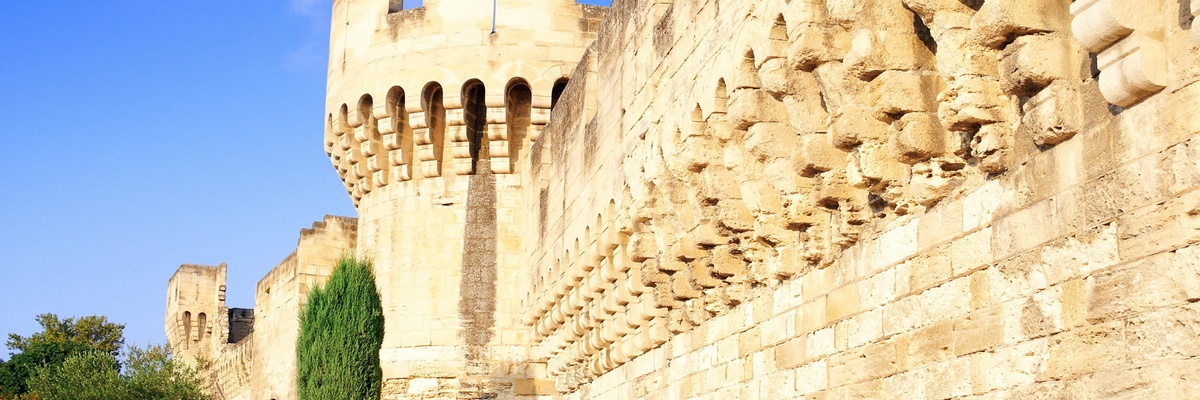
Le Palais des Papes
Place du Palais des Papes
84000 AVIGNON
website: https://www.palais-des-papes.com
If you visit Avignon, you cannot miss the Popes’Palace, one of the biggest Gothic palaces in Occident. The Palace welcomes more than 560,000 visitors per year and is one of the 10 most visited landmarks in France ! Classified « World Heritage of Humanity » by Unesco, the Popes’palace offers an exceptional moment.
The Saint Benezet bridge, a major witness of Avignon’s history, is known worldwide thanks to the famous song "Sur le Pont d'Avignon". Built in the twelfth century, it was often taken away by the floods of the Rhone, and its successive repairs were finally abandoned in the seventeenth century.
Classified World Heritage by UNESCO.
Pont d'Avignon
Boulevard de la Ligne
84000 AVIGNON
Phone : 04 32 74 32 74
fax: 04 90 27 51 08
mail: officetourisme@avignon-tourisme.com
website: https://www.avignon-pont.com
According to the legend, the bridge was built in the twelfth century by a young shepherd from Vivarais, Benezet, on celestial order. Completed in 1185, it was the first passage across the Rhone between Lyon and the sea, then the bridge stretched on 900 meters and had 22 arches. Dismantled in 1226, rebuilt and carried away several times by the Rhône, its use was abandoned in the seventeenth century. Nowaday, it has only four arches and a chapel dedicated to St. Nicolas. It is famous around the world thanks to the children's song "Sur le Pont d'Avignon".
The Bridge construction :
The first element of the bridge is the pillar supporting the Romanesque chapel of Saint Benezet, built in the twelfth century. This pillar was probably connected by wooden walkways to the shore of Avignon. The first work of the construction as a whole appeared later and dated back to 1230s.
At that time, the brotherhood of "the work of the bridge", born from the influence of Benezet, brought together 24 brothers.
Through their relentless quests and the clever use of tolls, they could undertake the construction of a stone Gothic bridge, on the same principle of bridges equally famous in the region: the Pont du Gard or the Julien Bridge of Bonnieux.
Built on the pebble beds, this bridge stretched for about 900 meters and has some 22 arches. It is not straight but follows a winding course.
It enabled to control especially the important river traffic which borrowed this natural way north / south. In the Middle Ages, the Pont St Benezet also integrated on one of the most important pilgrimage routes between Italy and Spain. It would become essential to the papal court when it moved to Avignon in the fourteenth century.
Very quickly, the Cardinals moved to Villeneuve to escape the pollution of Avignon, then qualified by the poet Petrarch "the foulest and most stinking cities of the earth." The bridge was at that time the most direct link between the many residences that were made to build the cardinals, and the Pope Palace, located within the city walls of Avignon. At each crossing the bridge, the Popes had a habit of stopping in front of the chapel to pray Benezet for a moment and leave an alms of a florin.
Located in the heart of the Alpilles on a rocky plateau, Les Baux de Provence dominate Arles and the Camargue and offer a breathtaking panorama. Patiently restored, the city has a historical and architectural heritage of 22 listed monuments.
phone: +33 (0) 4 90 54 34 39
fax: +33 (0) 4 90 54 51 15
mail: tourisme@lesbauxdeprovence.com
website: https://www.lesbauxdeprovence.com
A situation and a remarkable heritage
Ranked Station, Remarkable Site of Taste, Most Beautiful Villages of France, Les Baux-de-Provence affirm their prestige image site within the Regional Park of the Alpilles.
Les Baux-de-Provence is unique because a little more magic and a little more famous in this extraordinary setting. However, the essence that makes the so distinctive Provencal villages charm and flavour is there: small squares, shaded terraces, narrow streets and shops.
The Château des Baux is a unique testimony of medieval history, the Church of Saint Vincent is both Romanesque and Renaissance with its beautiful Max Ingrand stained glass, the Post Tenebras Lux renaissance window, which shows the influence of the Huguenots in the eleventh century, mansions of the sixteenth and seventeenth century hosting art galleries and museums such as the Musée Yves Brayer, the Santons Museum and the Louis Jou Foundation, where you will discover other treasures, not forgetting the City Hall which occupies the former Hotel de Manville.
At the heart of the Alpilles, the monumental Carrières de Lumières, 14 meters high, hosts unique multimedia shows.
A masterpiece of ancient architecture, the aqueduct of Pont du Gard is one of the most beautiful Roman buildings in the region.
The Pont du Gard
La Bégude
400 Route Pont du Gard
30210 VERS-PONT-DU-GARD
Phone : 04 66 37 50 99
fax: 04 66 37 51 50
mail: contact@pontdugard.fr
website: https://www.pontdugard.fr
The Pont du Gard is an aqueduct built by the Romans in the 1st century of our era.
It is exceptional for its size since with its 49 meters high, this is the highest Roman aqueduct in the world.
It consists of 3 rows of overlapping arches (6 arches on the first level, 11 arches at the second level and 47 arches at the top), which is also a rare achievement for the time.
Finally, it is remarkable because of its excellent state of preservation that makes it admired as a masterpiece of human creative genius.
It is the only example of 3 floors ancient bridge still standing today. Nearly a thousand men worked on this colossal project completed in only 5 years.